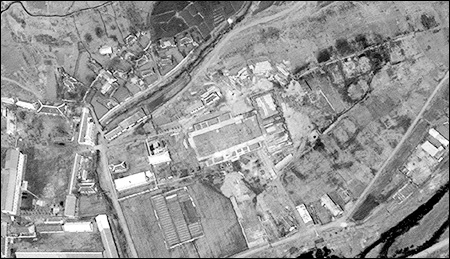North Korea upgrades rocket launch pad

- This April 29 satellite image provided by DigitalGlobe shows what appears to be the initial stages of construction of a rocket assembly building at Musudan-ri in northeastern North Korea. The U.S.-Korea Institute at Johns Hopkins School of Advanced International Studies says this building and a nearby launch pad under construction are upgrading facilities so the site can handle larger rockets.
North Korea is revamping a launch pad at its northeastern site of Musudan-ri in an apparent bid to expand its missile capabilities, satellite imagery showed Wednesday.
Photographs taken late last month showed the North has made rapid progress on the pad and razed a nearby village to build a large-scale assembly building, according to website 38 North, which unveiled the images.
The construction comes amid tension over Pyongyang’s failed April 13 launch of a Unha-3 long-range rocket from the newer, northwest site at Dongchang-ri.
“The new construction is intended to support future launches of rockets larger than the recently tested Unha — more capable liquid fueled space launch vehicles or missiles with intercontinental ranges — that will also overfly Japan, further aggravating regional tensions,” the website said.
The site, under construction since last summer, is still in the early stages. At the current pace it will likely be operational no earlier than 2017, the site said.
Other developments include the creation of a flame trench, foundations for fuel and oxidizer tank buildings and a nearby dam connected to a water container at the main facility and other buildings.
The trench, larger than at the previous launch pad, and the distance between four concrete footings likely for a new rocket gantry suggest the upgrades are to accommodate rockets larger than the recently-tested Unha.
The North conducted missiles launches from the site in 1998 and 2009.
The April launch took place from the new site and avoided overflying Japan. Despite insisting it was to put a satellite into orbit for science, the international community slammed the move and expanded sanctions on the isolated state.
The region is on the lookout for more North Korean provocations including a possible third nuclear test after satellites showed preparations being made at an underground test site.
On Tuesday, the North’s state media indicated no nuclear test was imminent, saying Pyongyang had informed Washington it was refraining from provocative actions. However, it added that if the United States continued its “hostile policy” it would have “no option but to take counter-measures for self-defense.”
U.S. officials responded by saying it was up to the North to rebuild trust shattered by the launch, which broke a bilateral deal under which Pyongyang would gain nutritional aid in exchange for denuclearization steps.
“We’re going to be guided not by what they say, but what they do,” State Department spokeswoman Victoria Nuland told reporters. Washington wants Pyongyang to honor denuclearization promises made under the six-party talks framework.
Yoo Ho-yeol, a North watcher at Korea University, said the North was apparently indicating it had heeded pressure from Beijing, its closest ally, not to carry out the test, but that it was willing to go through with the move if Washington did not move towards resumption of bilateral talks.
The expert said the Obama administration, facing upcoming presidential elections, would be pressured not to talk unless the North began making moves such as suspending its uranium enrichment program at its Yongbyon site.
“They already failed Washington’s test by firing the rocket,” he said. “So the administration needs to convince its people that it would be worthwhile to talk again.” <Korea Time/Kim Young-jin>






















































